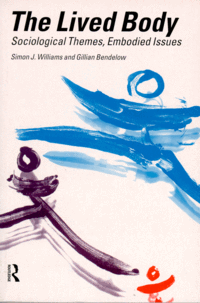

![]()
![]()

Most of the book is dedicated to reviewing interpretations of the body by leading social thinkers. Chapter One, "Sociology and the 'Problem' of the Body", suggests that classical sociologists such as Marx, Weber and Durkheim did consider the body, but were wary of biological reductionism. Subsequently, the discipline of sociology marginalised the question of embodiment. Chapter Two, "Bodily 'Order': Cultural and Historical Perspectives on Conformity and Transgression", examines more recent theorising about the body. A review of the work of Foucault, Elias and others indicates that many sociologists adopt a passive view of the body, dominated by society. Williams and Bendelow believe it is possible to overcome this limitation by recognising the importance of corporeality. They suggest social order is ultimately connected to notions of bodily conformity and transgression.
Chapter Three, "Bodily 'Control': Body Techniques, Intercorporeality and the Embodiment of Social Action" further examines the ways in which sociologists have theorised embodied agency and control. The concept of habitus is criticised for being too static and unable to explain social change. The "sentient body-subject" and the concept of "intercorporeality" are regarded as more useful concepts, if combined with a recognition of the ways in which the body mediates between social and personal identity. Williams and Bendelow stress that the body operates at the intersection of discourses, institutions and corporeality.
The authors argue that we are living in the age of high modernity in Chapter Four, "The Body in 'High' Modernity and Consumer Culture". They suggest that this era is characterised by technological development, reflexivity, uncertainty, risk and the pressures of commodification. These experiences are necessarily grounded in human embodiment.
The approach of psychoanalysis to the body is examined in Chapter Five, "The 'Libidinal' Body: Psychoanalysis, Critical Theory and the Problem of Human Desire". The Chapter starts with Freud's work on bodily ego, then considers Lacar's idea of 'imaginary anatomy' and Schilder's analysis of body image. However, the authors feel that the connections between biological, psychological and social experiences are more fully explored by 'social revolutionaries' such as Marcuse and Reich.
In Chapter Six, "'Uncontainable' Bodies? Feminisms, Boundaries and Reconfigured Identities", Williams and Bendelow argue that the work of feminist scholars has been one of the most sustained attempts to grapple with gendered embodiment and to take sexual difference seriously. Feminist writers have made a significant contribution towards overcoming the dualist legacies of the past by acknowledging that biology need not be ignored nor considered as determinative. Instead, the most promising feminist work problematises the concepts of gender, sexuality and sexual difference and recognises that bodies are both socially constructed and material.
Chapters Seven, Eight, Nine and Ten examine four relatively unexplored areas within embodied sociology: pain, emotions, sleep and art. "The Emotionally 'Expressive' Body" examines theories about human emotions and their potential to contribute to debates about biological determinism and social constructionism. Emotions are important, because they are embodied experiences which involve an active engagement with both self and society. Williams and Bendelow develop the concept of "socialised biology", which they suggest links the health of an agent to wider social structures. Chapter Eight, which considers "Pain and the 'Dys-appearing' body", discusses the way pain is situated between body, mind and culture. Analyses of pain therefore demand a theoretical shift away from mind/body dichotomies and imply a need to move away from a medicalised view of pain. (Oddly, however, the authors did not engage with the extensive literature on disability in this discussion). Chapter Nine suggests that sleep also remains under-theorised, even though it impacts upon agency, activity and issues of time and space. Sleep raises questions of bodily control and is also tied up with notions of social order. Chapter Ten suggests that art is another area where dominant ideas about the body are both displayed and challenged. It examines artistic bodies (photography, performance art, media representations, and so on) in order to demonstrate the key themes of power, control and resistance in an embodied context.
The brief Conclusion suggests dichotomous categories such as mind/body, nature/culture and reason/emotion are an unsatisfactory way to theorise embodiment. Williams and Bendelow argue that there is a need to move beyond thinking "about bodies" to thinking "from bodies as lived entities". This is the essence of their call for an "embodied sociology".
This book can be difficult to read, so I would probably consider it too dense and complex for undergraduates. However, it may be quite useful to postgraduates who are grappling with the complexities and nuances of contemporary sociological thinking about the body. My major criticism would be the failure to integrate recent writing on disability within this context.
Mark Sherry
University of Queensland